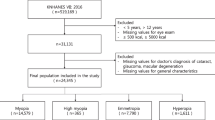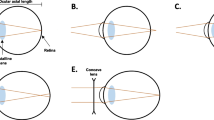Abstract
Myopia is a worldwide public health problem of vision disorder caused by multiple factors, which has posed a huge socioeconomic burden, raising concerns about sight-threatening ocular complications. Vitamin D, as a kind of fat-soluble vitamin, related to time-spent-outdoors, has been considered by extensive studies to have potential relationship with myopia. We reviewed studies published in a decade which estimated the association of blood vitamin D status with myopia and summarized the universality and individuality of all research articles. Several research articles suggested the known environmental risk factors of myopia, including age, gender, ethnicity, education level, parental and school conditions, time-spent-outdoors, and sunlight exposure, and recent epidemiological studies demonstrate that increased vitamin D levels, by virtue of the extended outdoor time, may be an important modifiable factor and a protective effect that delay the progression of myopia in children and adolescents rather than in adults. The genetic studies have been conducted to get access to the evidence of gene polymorphism for explaining the association of serum vitamin D status and myopia, but the precise genetic interpretation of vitamin D and myopia remains unclear so far; on the other hand, the possible mechanisms are various like copolymerization mechanism, calcium homeostasis and imbalance of ciliary muscle function regulation, but nearly all of the investigators are inclined to remain skeptical. This article reviews the age-related epidemiological proofs, existent genetics correlations, possible underlying biological mechanisms and further values for the protective association between vitamin D and myopia, providing the possibility of prevention or postponement for myopia.
Similar content being viewed by others
References
Holden BA, Fricke TR, Wilson DA et al (2016) Global prevalence of myopia and high myopia and temporal trends from 2000 through 2050. Ophthalmology 5:1036–1042. https://doi.org/10.1016/j.ophtha.2016.01.006
Villa-Collar CCG, González-Méijome JM et al (2019) Myopia, the challenge of ophthalmology and its worldwide “explosive epidemic.” Arch Soc Esp Oftalmol. https://doi.org/10.1016/j.oftal.2018.10.006
Dong L, Kang YK, Li Y et al (2020) Prevalence and time trends of myopia in children and adolescents in China: a systemic review and meta-analysis. Retina. https://doi.org/10.1097/IAE.0000000000002590
Baird PN, Saw SM, Lanca C et al (2020) Myopia. Nat Rev Dis Primers 1:99. https://doi.org/10.1038/s41572-020-00231-4
Haarman AEG, Enthoven CA, Tideman JWL et al (2020) The complications of myopia: a review and meta-analysis. Invest Ophthalmol Vis Sci 4:49. https://doi.org/10.1167/iovs.61.4.49
Jeffrey C, Tkatchenko AV (2018) A review of current concepts of the etiology and treatment of myopia. Eye Contact Lens. https://doi.org/10.1097/IAE.0000000000001489
Smith EL (2013) Optical treatment strategies to slow myopia progression: effects of the visual extent of the optical treatment zone. Exp Eye Res 1:77–88. https://doi.org/10.1016/j.exer.2012.11.019
Wang WY, Chen C, Chang J et al (2021) Pharmacotherapeutic candidates for myopia: a review. Biomed Pharmacother. https://doi.org/10.1016/j.biopha.2020.111092
Saw SM, Matsumura S, Hoang QV (2019) Prevention and management of myopia and myopic pathology. Investig Ophthalmol Vis Sci. https://doi.org/10.1167/iovs.18-25221
Jonker SR, Berendschot T, Saelens IY et al (2020) Phakic intraocular lenses: an overview. Indian J Ophthalmol 12:2779. https://doi.org/10.4103/ijo.IJO_2995_20
Wildsoet CF, Chia A, Cho P et al (2019) IMI—interventions myopia institute: interventions for controlling myopia onset and progression report. Invest Ophthalmol Vis Sci 3:M106-m131. https://doi.org/10.1167/iovs.18-25958
O’Donoghue L, Kapetanankis V et al (2015) Risk factors for childhood myopia: findings from the NICER study. Investig Ophthalmol Vis Sci. https://doi.org/10.1167/iovs.14-15549
Morgan IG, Wu PC, Ostrin LA et al (2021) IMI risk factors for myopia. Invest Ophthalmol Vis Sci 5:3. https://doi.org/10.1167/iovs.62.5.3
Holton V, Hinterlong JE, Tsai CY et al (2021) A nationwide study of myopia in taiwanese school children: family, activity, and school-related factors. J Sch Nurs 2:117–127. https://doi.org/10.1177/1059840519850619
Pan CW, Ramamurthy D, Saw SM (2012) Worldwide prevalence and risk factors for myopia. Ophthalmic Physiol Opt 1:3–16. https://doi.org/10.1111/j.1475-1313.2011.00884.x
Ngo C, Saw SM, Dharani R et al (2013) Does sunlight (bright lights) explain the protective effects of outdoor activity against myopia? Ophthalmic Physiol Opt 3:368–372. https://doi.org/10.1111/opo.12051
Laval J (1938) Vitamin D and myopia. Arch Ophthalmol 4:612–612. https://doi.org/10.1001/archopht.1938.00850160138010
Pan CW, Qian DJ, Saw SM (2017) Time outdoors, blood vitamin D status and myopia: a review. Photochem Photobiol Sci 3:426–432. https://doi.org/10.1039/c6pp00292g
Chou HD, Yao TC, Huang YS et al (2020) Myopia in school-aged children with preterm birth: the roles of time spent outdoors and serum vitamin D. Br J Ophthalmol. https://doi.org/10.1136/bjophthalmol-2019-315663
Holick MF (2004) Sunlight and vitamin D for bone health and prevention of autoimmune diseases, cancers, and cardiovascular disease. Am J Clin Nutr 6:1678S. https://doi.org/10.1093/ajcn
Holick MF (2004) Sunlight and vitamin D for bone health and prevention of autoimmune diseases, cancers, and cardiovascular disease. Am J Clin Nutr 6(Suppl):1678s–1688s. https://doi.org/10.1093/ajcn/80.6.1678S
Williams KM, Bentham GCG, Young IS et al (2017) Association between myopia, ultraviolet B radiation exposure, serum vitamin D concentrations, and genetic polymorphisms in vitamin D Metabolic pathways in a multicountry European study. Jama Ophthalmol 1:47. https://doi.org/10.1001/jamaophthalmol.2016.4752
Tripkovic L, Lambert H, Hart K et al (2012) Comparison of vitamin D2 and vitamin D3 supplementation in raising serum 25-hydroxyvitamin D status: a systematic review and meta-analysis. Am J Clin Nutr 6:1357–1364. https://doi.org/10.3945/ajcn.111.031070
Martineau AR, Thummel KE, Wang Z et al (2019) Differential effects of oral boluses of vitamin D2 vs vitamin D3 on vitamin D metabolism: a randomized controlled trial. J Clin Endocrinol Metab 12:5831–5839. https://doi.org/10.1210/jc.2019-00207
Wu PC, Tsai CL, Wu HL et al (2013) Outdoor activity during class recess reduces myopia onset and progression in school children. Ophthalmology 5:1080. https://doi.org/10.1016/j.ophtha.2012.11.009
Jin JX, Hua WJ, Jiang X et al (2015) Effect of outdoor activity on myopia onset and progression in school-aged children in northeast china: the Sujiatun eye care study. BMC Ophthalmol. https://doi.org/10.1186/s12886-015-0052-9
He M, Xiang F et al (2015) Effect of time spent outdoors at school on the development of myopia among children in China. JAMA. https://doi.org/10.1001/jama.2015.10803
Lucas RM, Ponsonby A-L, Dear K et al (2011) Sun exposure and vitamin D are independent risk factors for CNS demyelination. Neurology. https://doi.org/10.1212/WNL.0b013e31820af93d
Choi JA, Kyungdo H, Yong-Moon P et al (2014) Low serum 25-hydroxyvitamin D is associated with myopia in Korean adolescents. Invest Ophthalmol Vis 4:2041–2047. https://doi.org/10.1167/IOVS.13-12853
Guggenheim JA, Williams C, Northstone K et al (2014) Does vitamin D mediate the protective effects of time outdoors on myopia? Findings from a prospective birth cohort. Investig Ophthalmol Vis Sci. https://doi.org/10.1167/iovs.14-15839
Hanjun Z (2019) Correlation between serum 25(OH)D concentration and myopia in children and adolescents
Kwon J, Choi JA, La TY (2016) Serum 25-hydroxyvitamin D level is associated with myopia in the Korea national health and nutrition examination survey. Medicine. https://doi.org/10.1097/MD.0000000000005012
Mutti DO, Marks AR (2011) Blood levels of vitamin D in teens and young adults with myopia. Optom Vis Sci 3:377–382. https://doi.org/10.1097/OPX.0b013e31820b0385
Seyhan Y (2014) Myopia is associated with lower vitamin D status in young adults. Investig Ophthalmol Vis Sci. https://doi.org/10.1167/iovs.14-14589
Shen Li YC (2015) Serum levels of vitamin D in children with myopia. Chin J Ophthalmol Otorhinolaryngol. 002:94–97. https://doi.org/10.14166/j.issn.1671-2420.2015.02.005
Tideman JWL, Polling JR, Voortman T et al (2016) Low serum vitamin D is associated with axial length and risk of myopia in young children. Eur J Epidemiol 5:491–499. https://doi.org/10.1007/s10654-016-0128-8
Lingham G, Mackey DA, Zhu K et al (2021) Time spent outdoors through childhood and adolescence—assessed by 25-hydroxyvitamin D concentration—and risk of myopia at 20 years. Acta Ophthalmol 99:679–687
Li X, Lin H, Jiang L et al (2022) Low serum vitamin D is not correlated with myopia in Chinese children and adolescents. Front Med (Lausanne). https://doi.org/10.3389/fmed.2022.809787
Han SB, Jang J, Yang HK et al (2019) Prevalence and risk factors of myopia in adult Korean population: Korea national health and nutrition examination survey 2013–2014 (KNHANES VI). PLoS ONE. https://doi.org/10.1371/journal.pone.0211204
Lingham G, Milne E, Cross D et al (2018) Investigating the long-term impact of a childhood sun-exposure intervention, with a focus on eye health: protocol for the Kidskin-Young Adult Myopia Study. BMJ Open. https://doi.org/10.1136/bmjopen-2017-020868
Annamaneni S, Bindu CH et al (2011) Association of vitamin D receptor gene start codon (Fok1) polymorphism with high myopia. Oman J Ophthalmol. https://doi.org/10.4103/0974-620X.83654
Mutti DO, Cooper ME, Dragan E et al (2011) Vitamin D receptor (VDR) and group-specific component (GC, Vitamin D-Binding Protein) polymorphisms in myopia. Investig Ophthalmol Vis Sci 6:3818–3824. https://doi.org/10.1167/iovs.10-6534
Nakanishi H, Yamada R, Gotoh N et al (2009) A genome-wide association analysis identified a novel susceptible locus for pathological myopia at 11q24.1. PLoS Genet 9:140–145. https://doi.org/10.1371/journal.pgen.1000660
Hysi PG, Young TL, Mackey DA et al (2010) A genome-wide association study for myopia and refractive error identifies a susceptibility locus at 15q25. Nat Genet. https://doi.org/10.1038/ng.664
Solouki AM, Verhoeven VJM, Duijn CM et al (2010) A genome-wide association study identifies a susceptibility locus for refractive errors and myopia at 15q14. Nat Genet. https://doi.org/10.1038/ng.663
Marc S, Caroline D, Sylvie B et al (2009) Genetic polymorphisms of the vitamin D binding protein and plasma concentrations of 25-hydroxyvitamin D in premenopausal women. Am J Clin Nutr. https://doi.org/10.3945/ajcn.2008.26445
Seko Y, Shimokawa H, Tokoro T (1996) In vivo and in vitro association of retinoic acid with form-deprivation myopia in the chick. Exp Eye Res 4:443–452. https://doi.org/10.1006/exer.1996.0134
Taveramendoza LE, Wang T, Lallemant B et al (2006) Convergence of vitamin D and retinoic acid signalling at a common hormone response element. EMBO Rep 2:180–185. https://doi.org/10.1038/sj.embor.7400594
Duan X, Lu Q, Xue P et al (2008) Proteomic analysis of aqueous humor from patients with myopia. Mol Vis 45:370–377. https://doi.org/10.1016/j.moicatb.2007.10.003
Bailey MD, Sinnott LT, Mutti DO (2008) Ciliary body thickness and refractive error in children. Investig Ophthalmol Vis Sci 10:4353. https://doi.org/10.1167/iovs.08-2008
Carroll W, Fabres J, Nagy TR et al (2011) Results of extremely low birth weight infants randomized to receive extra enteral calcium supply. J Pediatr Gastroenterol Nutr 3:339–345. https://doi.org/10.1097/MPG.0b013e3182187ecd
Dallosso HM, Mcgrother CW, Matthews RJ et al (2004) Nutrient composition of the diet and the development of overactive bladder: a longitudinal study in women. Neurourol Urodyn 3:204–210. https://doi.org/10.1002/nau.20028
Ramamurthy D, Chua SYL, Saw SM (2016) A review of environmental risk factors for myopia during early life, childhood and adolescence. Clin Exp Optom 6:497–506. https://doi.org/10.1111/cxo.12346
Jun Z, Guohua D (2019) Protective effects of increased outdoor time against myopia: a review. J Int Med Res. https://doi.org/10.1177/0300060519893866
Polling JR, Verhoeven VJM, Tideman JWL et al (2016) Duke-elder’s views on prognosis, prophylaxis, and treatment of myopia: way ahead of his time. Strabismus. https://doi.org/10.3109/09273972.2015.1137706
Stephanie K, Lisa OD, Pourshahidi LK et al (2019) Conjunctival ultraviolet autofluorescence area, but not intensity, is associated with myopia. Clin Exp Optom. https://doi.org/10.1111/cxo.12825
Mccarthy CS, Megaw P, Devadas M et al (2007) Dopaminergic agents affect the ability of brief periods of normal vision to prevent form-deprivation myopia. Exp Eye Res 1:100–107. https://doi.org/10.1016/j.exer.2006.09.018
Acknowledgements
This study was supported by the Capital Health Research and Development of Special (2020-1-2052); Science & Technology Project of Beijing Municipal Science & Technology Commission (Z201100005520045, Z181100001818003); the Beijing Municipal Administration of Hospitals’ Ascent Plan (DFL20150201).
Funding
Supported by National Natural Science Foundation of China (82141128); The Capital Health Research and Development of Special (2020-1-2052); Science & Technology Project of Beijing Municipal Science & Technology Commission (Z201100005520045, Z181100001818003).
Author information
Authors and Affiliations
Corresponding author
Ethics declarations
Conflict of interest
The authors declare that they have no conflict of interest.
Ethics approval
This article does not contain any studies with human participants or animals performed by any of the authors.
Consent for publication
All the authors support the publication of this article.
Additional information
Publisher's Note
Springer Nature remains neutral with regard to jurisdictional claims in published maps and institutional affiliations.
Rights and permissions
Springer Nature or its licensor (e.g. a society or other partner) holds exclusive rights to this article under a publishing agreement with the author(s) or other rightsholder(s); author self-archiving of the accepted manuscript version of this article is solely governed by the terms of such publishing agreement and applicable law.
About this article
Cite this article
Yu, CY., Dong, L., Li, YF. et al. Vitamin D and myopia: a review. Int Ophthalmol 44, 95 (2024). https://doi.org/10.1007/s10792-024-03009-9
Received:
Accepted:
Published:
DOI: https://doi.org/10.1007/s10792-024-03009-9




